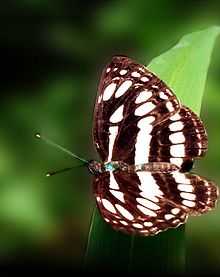Neptis hylas
| Common Sailer | |
|---|---|
 | |
| upper-side | |
| | |
| underside | |
| Scientific classification | |
| Kingdom: | Animalia |
| Phylum: | Arthropoda |
| Class: | Insecta |
| Order: | Lepidoptera |
| Family: | Nymphalidae |
| Genus: | Neptis |
| Species: | N. hylas |
| Binomial name | |
| Neptis hylas (Linnaeus, 1758) | |
| Synonyms | |
|
Neptis varmona, Moore, 1872 | |
The Common Sailer (Neptis hylas) is a species of nymphalid butterfly found in the Indian Subcontinent and Southeast Asia. It has a characteristic stiff gliding flight achieved by short and shallow wingbeats just above the horizontal.
Description

Dry-season form - Upperside black, with pure white markings. Fore wing discoidal streak clavate, apically truncate, subapically either notched or sometimes indistinctly divided; triangular spot beyond broad, well-defined, acute at apex, but not elongate; discal series of spots separate, not connate, each about twice as long as broad; postdiscal transverse series of small spots incomplete, but some are always present. Hind wing: subbasal band of even or nearly oven width ; discal and subterminal pale lines obscure; postdiscal series of spots well separated, quadrate or subquadrate, very seldom narrow. Underside from pale golden ochraceous to dark ochraceous almost chocolate ; white markings as on the upperside, but broader and defined in black. Fore wing: interspaces 1 a and 1 from base to near the apex shaded with black, some narrow transverse white markings on either side of the transverse postdiscal series of small spots. Hind wing a streak of white on costal margin at base, a more slender white streak below it; the discal and subterminal pale lines of the upperside replaced by narrow white lines with still narrower margins of black. Antennae, head, thorax and abdomen black; the palpi, thorax and abdomen beneath dusky white.

Wet-season form - Differs only in the narrowness of the white markings and in the slightly darker ground-colour and broader black margins to the spots and bands on the underside.[1]
This species has been observed to make sounds whose function has not been established.[2]
Distribution
Throughout continental India; Sri Lanka; Assam; Myanmar (Tenasserim), extending to China and Indomalaya.

Life history
Larva
Race varmona = eurynome. Frederic Moore describes this from a drawing by Mr. S. N. Ward (Samuel Neville Ward) as follows:
"Head larger than anterior segment, vertex with two short pointed spines, cheeks obtusely spined; third, fourth, sixth and twelfth segments armed with a subdorsal pair of stout fleshy spiny processes, those on the fourth segment longest. Colour pale green; face, tip of processes and segments slightly washed with pale pinkish, a slight pinkish oblique lateral fascia from anal process; a small, dark, lateral spot on sixth segment."[1]
Pupa
"Rather short; head-piece bluntly cleft in front, vertex pointed; thorax dorsally prominent and angular; dorsum angular at base; abdominal segments slightly angled dorsally; wing-cases somewhat dilated laterally. Colour pale brownish ochreous, with lateral thoracic golden spots."[1]